1821
React Vs React Native: Which One to Choose in 2023?
7 min read
Table of Content
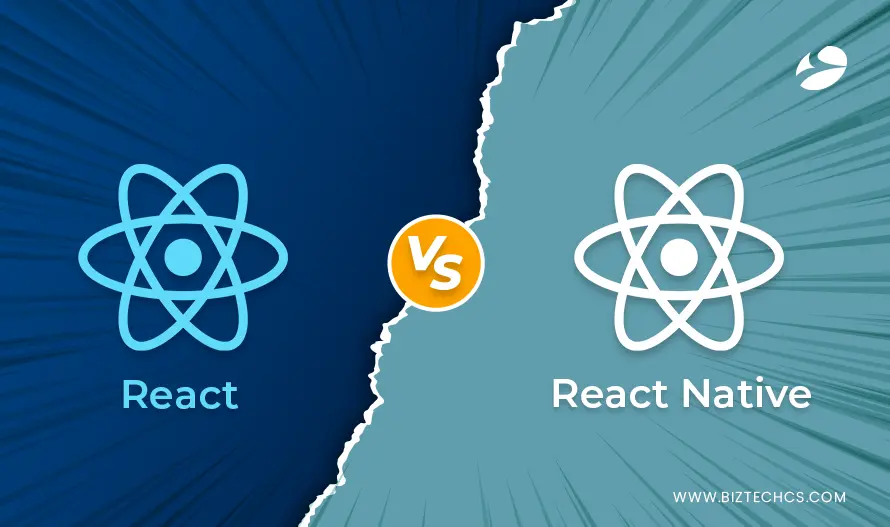
The increasing demand for developing multi-platform applications led to the innovation of new frameworks. Frameworks like React Native, Flutter, Xamarin, and more which support cross-platform app development.
Today, React Native is one of the key players when it comes to developing cross-platform applications. A Statista report suggests the year-on-year popularity of React Native over other platforms like Cordova, Ionic, Xamarin, and Kotlin multiplatform between 2019 and 2021.
React Native Developers prefer it because it is easier to learn. But, with this, there is also increasing confusion about React vs React Native. It is the most debated question and so finally here is your answer.
In this blog post, I will walk you through the difference between React JS (often called ‘React’) and React Native. If you are someone who is often confused between these two, you are at the right place.
Read more, to know everything about the two technologies before we can compare Reactjs vs React Native.
ReactJS is the JavaScript library that supports front-end and server-side development. You can even use it to develop user interfaces for mobile applications and websites.
Its major purpose is to manage and handle the view layer of the application. It provides developers with complex UIs from the small piece of code known as Components.
ReactJS is made of two parts i.e. Components and HTML documents.
Components, contain HTML code and what you want to see in the user interface.
HTML documents, to render all components.
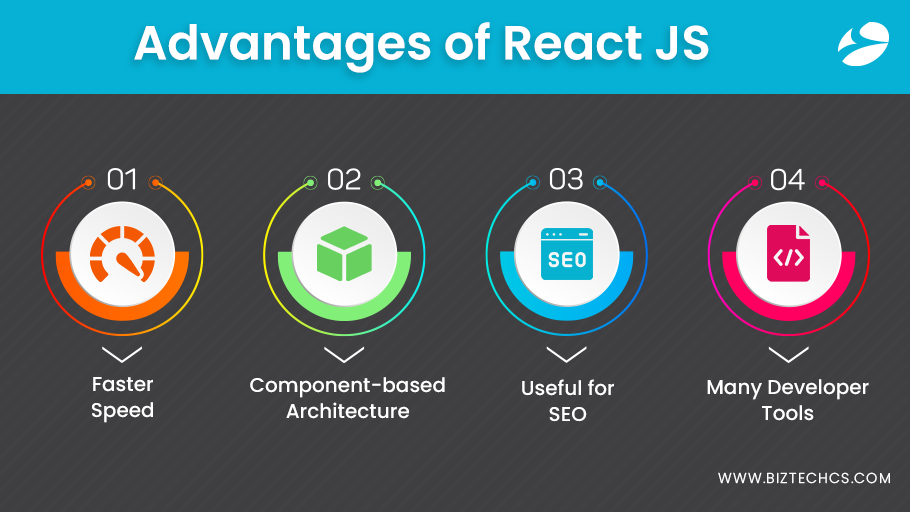
ReactJS has the ability to load the website and applications faster as it uses Document Object Model (DOM). React develops an in-memory data structure cache that computes the resulting differences. It then updates the browser’s displayed DOM seamlessly.
The programmer writes the code in a way that the entire page renders whenever there are changes. But in reality, only the sub-components which you have changed render. This leads to faster loading of pages.
Component-based Architecture
ReactJS came up with the concept of component-based architecture, which focuses on the reusability of components. It in turn helps save time. It uses individual pieces of a large user interface and converts them into an independent, self-sustaining micro-system.
For example, you have made a website using ReactJs and want to make changes in certain sections. So, instead of changing the entire website, you can reuse and redefine particular components. Consequently, you save time and resources. Moreover, you don’t even have to go through the complexity of coding or running into any bugs.
Useful for SEO
When building a website or an application, you need to consider SEO ranking. It is a way of reaching more customers and increasing sales. Being a server-side rendering, it is useful to boost the SEO of the webpage/app and attract more organic traffic.
When a Google bot visits a server that has rendered content and images, then the indexing and caching become faster. It helps in the SEO of your website.
Moreover, if the Google bot directly indexes the content from the server side, the page load time also decreases. As a result, the website loads faster and users will not need to wait for a long time.
Many Developer Tools are Available
ReactJS has a large number of developers who contribute and develop an ecosystem of tools, component libraries, IDEs, extensions of code editors, web browsers, and more.
This provides developers with a wide range of third-party tools and extensions which help them in ReactJS app development. Due to the large support from the community and its open-source nature, ReactJS is one of the most popular choices when it comes to developing applications.
While there are plenty of benefits to React.js, there are some limitations too that you must note.
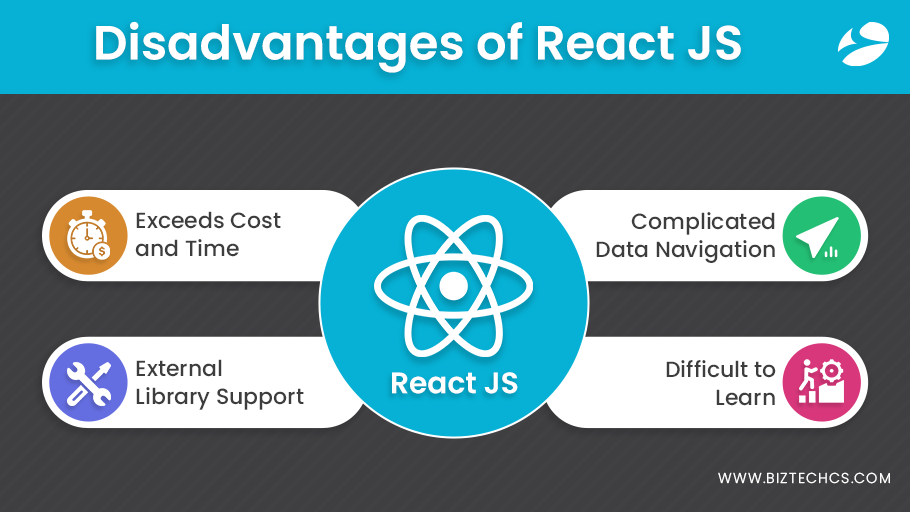
When you use React JS while working in a different framework, you will need to download the other extra components and libraries to work efficiently. This increases the cost and time of app development.
External Library Support
ReactJS supports many external, third-party libraries. There are very few native libraries for ReactJS. Today, external libraries can help developers use HTML and CSS functionalities and build in JavaScript XML i.e. JSX. But remember, even JSX has its complexities and difficulties while learning it.
Complicated Data Navigation
Data navigation within ReactJS is complicated because ReactJS doesn’t support parallel data handling like other JS Scripting tools. To navigate between the Divs in ReactJS, developers need to first navigate to the parent node, followed by the topmost parent node, and then to the second hierarchy of the tree node. This can be a difficult and tiring process to navigate between the data.
Bit Difficult to Learn
If you are new to development and thinking of learning ReactJS, it is a bit difficult compared to React Native. So, new developers need to have patience and not be hard on themselves.
However, if you are planning to outsource and hire ReactJS Developers, this shouldn’t be a matter of concern.
Now before we compare React vs React Native, let’s see React Native in detail.
React Native is a cross-platform mobile framework that uses ReactJS for developing applications and websites. It uses native app components which helps developers to build cross-platform mobile applications. ReactJS is useful to build components under React Native.
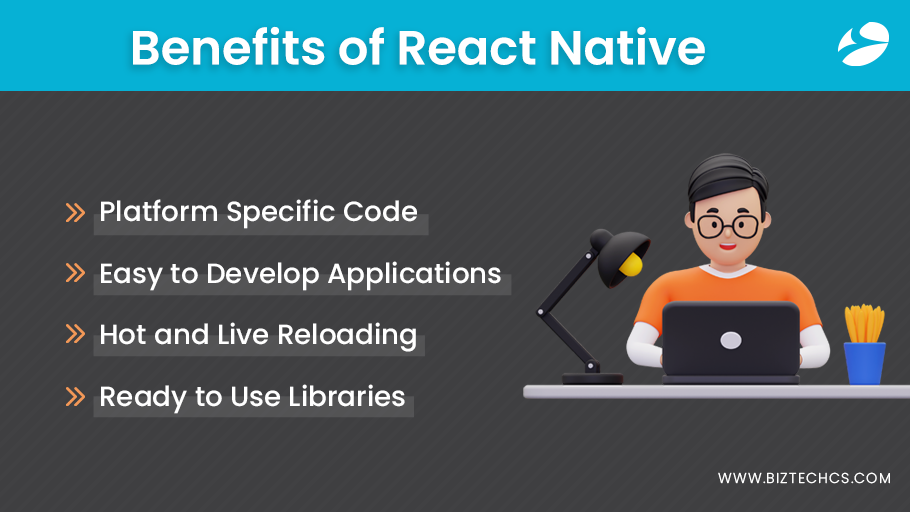
When you start with React Native app development, it automatically understands the platform it needs to run on. Thus, it generates the right code for the platform. This is one of the USPs of it and makes the development process simpler.
Easy to Develop Applications
React Native mostly uses JavaScript code of JavaScript which makes it easy to develop applications quickly, even if you are a front-end developer. You will just need to know JavaScript, platform APIs, some native UI elements, and any platform-specific design patterns.
As it is easy to use and learn, even non-programmers are attracted to it to develop applications. That’s one of the many many reasons why developers/ business owners prefer React Native for app development.
Hot and Live Reloading
Hot and Live reloading are the two most talked about benefits of React Native. Live Reloading can compile and read the changes made by a coder. It also uses a new file simulator which then automatically reads the app.
Hot Reload uses Hot Module Replacement and was introduced after the first reloading process. Hot Reloading has one advantage, that is, after saving changes in the file, an HMR intermediator comes forward and keeps the updated files in perfect places while the application operates in the background.
The main advantage of using Hot Reloading lies in the ability to make changes in the source code even when it does not recompile the application.
When the developer makes the changes in the code they can immediately see the results in real-time. Hence, with the help of Hot Reload, the waiting time for the output decreases.
Ready-to-Use Libraries
Component UI libraries exist in React Native which developers can use to make a smooth UI experience. Sharing of UI libraries like Shoutem, Expo, native base, and others can save time and there is no need to build the components from scratch. As a result, developers can focus on their work, and save time.
Owing to the significant benefits, several Best React Native Apps are here. For eg., Meta, Meta Ads Manager, Instagram, Shopify, Discord, and more.
Even so, there are some downsides to using React Native. Here are some!
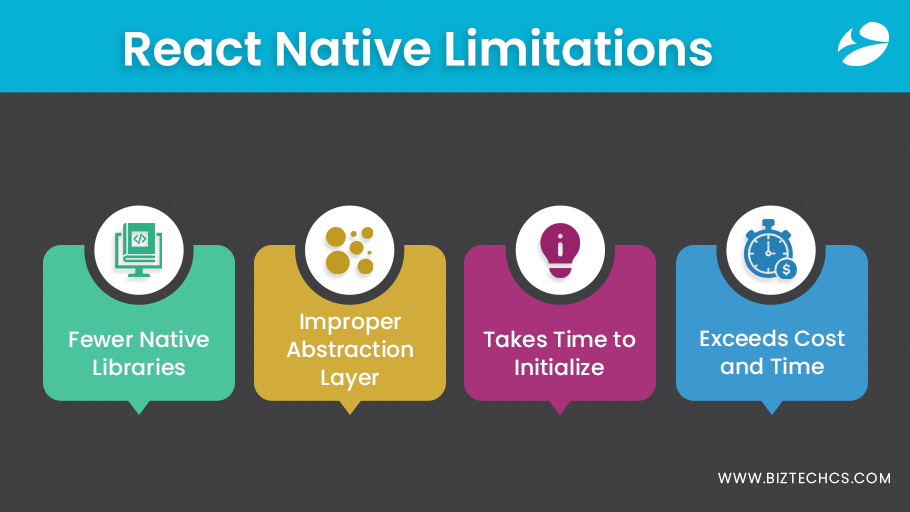
If the application has complex and heavy functionalities, the React Native app development process can slow down. It slows down because of fewer native libraries and dependencies on external or third-party libraries. When one needs to carry out complex calculations at the same time, then Swift, Objective-C, and Java are better alternatives.
Improper Abstraction Layer
React Native has a loose framework in which programmers can find tags like HTML, CSS style sheets, and JavaScript code. This looks like a benefit but has its own challenges as well.
As it does not have any defined rules like Java or Swift, the developers don’t need to add any parameters and anything can be a variable. This can lead to clashes of logic and difficulties can occur while writing programs.
Takes Time to Initialize
When this is initialized, it takes a lot of time to start the application. One of the major reasons is the JavaScript thread. But, this can become a problem in a long time.
Today, users are not used to waiting for a long time. So, you need to make sure you are providing better solutions and experiences for your application to users.
Exceeds Cost and Time
If the developer needs a particular functionality that is not found, then they are left with two options:
In either case, the development process consumes a lot of time and resources and makes the process complex.
Look into these React native vs React differences to pick the best one for your project!
I. Technology Base
React or React JS is a JS library used for developing web-based UI. It uses Javascript for development. So, you have to be proficient in Javascript to work with React.
Whereas, React Native is a mobile framework that uses React.js. It’s not completely a JS framework and requires proficiency in Java, C++, Objective C, and Objective C++.
II. Components
React is a component-based JS library. Two different kinds of components are used here:
React Native uses Native components and modules for developing cross-platform apps.
III. Storage
React JS uses local storage for managing and storing data. So, even if you close the browser window, you could still access the data as it has no expiration date.
You can also store data locally in React Native. However, you will have to use libraries to do so. By default, it uses Async storage.
IV. SEO-friendly
Since React (JS) builds web-based applications, you have to consider SEO aspects. Be it creating a responsive design or getting your web page indexed, you must use ReactJS to your advantage.
However, SEO is not of any importance for applications built using React Native. Since React Native is used for mobile applications, you might have to optimize your app for the app stores. But, SEO is not relevant here!
If you want to clearly distinguish between React vs React Native, just think about their purpose. While React is used for developing web-based applications or web-based UI components, React is used for mobile apps.
If you already know how to work with React, working with React Native will get easier. More so because React Native uses components built using React.
When it comes to choosing between either of them, you need to understand what you will need. React for web applications and both technologies for cross-platform mobile apps.
You can also use React Native for the web to turn your mobile app into a web app quickly. It is useful when you need the same features in both applications.
So, you don’t have to choose one between the two! Rather, you can decide where to use what. If you are thinking of getting started with app development, you can reach out to us anytime.
Hire ReactJS Developers or React Native Developers as you need and let our experts help you at each phase of app development!